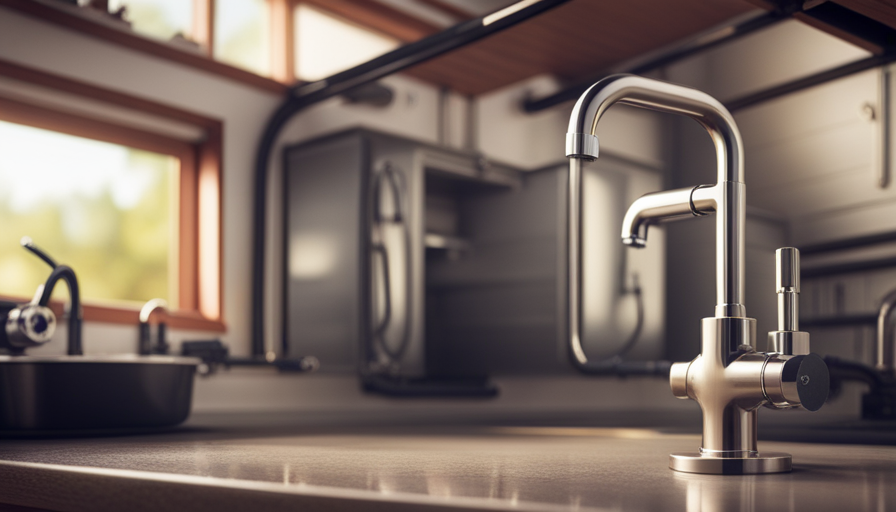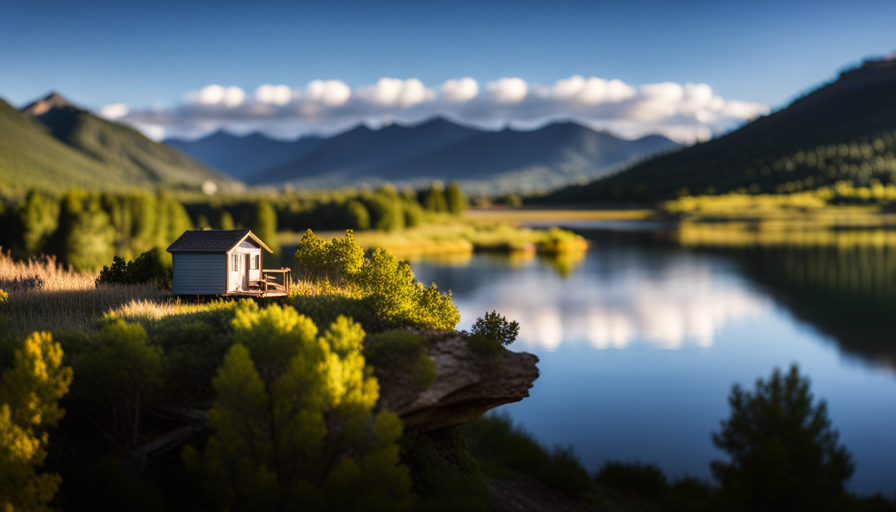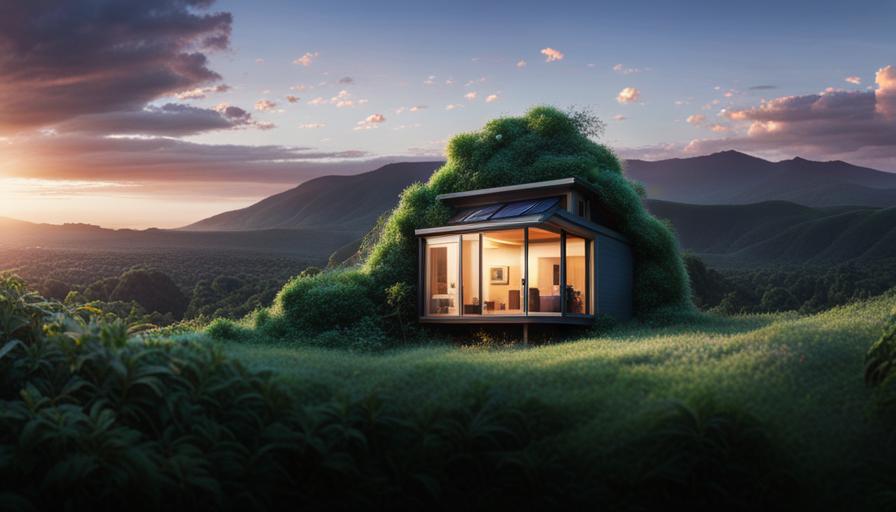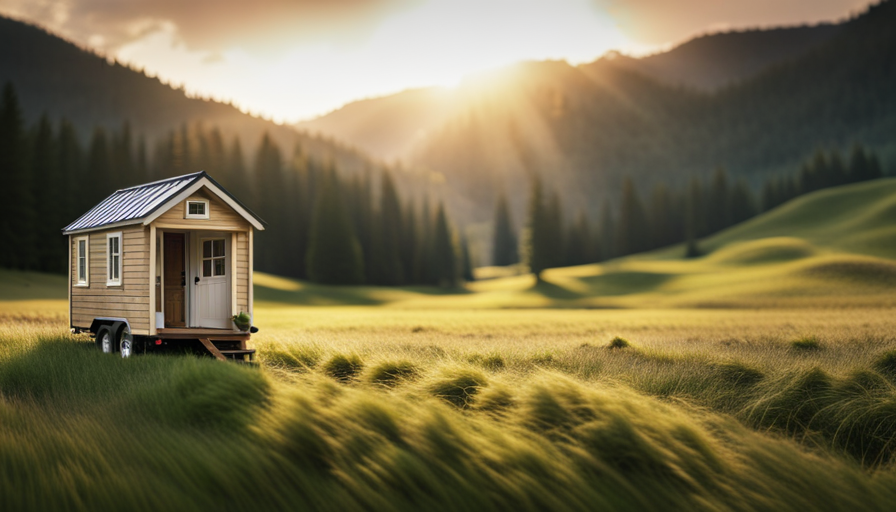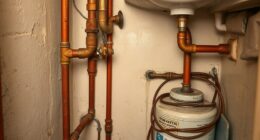Are you interested in learning more about how plumbing works in a small living area? It’s more complex than you may realize. Join us as we explore the intricacies of designing a plumbing system for a tiny house that maximizes space while still meeting all necessary functions.
From choosing the right fixtures and appliances to managing water supply and storage, we will delve into the technical aspects of plumbing in tiny houses. But it doesn’t stop there. We will also discuss waste water management and disposal, as well as greywater recycling and conservation techniques.
And of course, no plumbing system is complete without maintenance and troubleshooting tips. We will even touch on considerations for off-grid plumbing systems and the safety regulations that govern plumbing in tiny houses.
So, if you’re ready to dive into the world of plumbing in tiny houses, let’s get started!
Key Takeaways
- Designing a compact plumbing system is crucial for maximizing space and functionality in a tiny house.
- Tankless water heaters are compact and eliminate the need for a bulky tank.
- Dual-purpose fixtures such as sinks that serve as countertops or foldable showers maximize space.
- Proper plumbing fixture installation is crucial for a smooth and efficient plumbing system.
Designing a Compact Plumbing System
When designing a compact plumbing system for a tiny house, it’s crucial to maximize space without sacrificing functionality. Compact plumbing design is all about finding space-saving plumbing solutions that can fit within the limited square footage of a tiny house.
One of the key considerations is the layout of the plumbing pipes. By strategically placing the pipes along the walls or under the floor, we can save valuable space and ensure efficient water flow throughout the house. Additionally, using smaller diameter pipes can further minimize the space required for the plumbing system.
Another space-saving solution is the use of tankless water heaters. Unlike traditional water heaters that require a large storage tank, tankless water heaters are compact and can be installed in tight spaces. These units heat water on demand, eliminating the need for a bulky tank.
Incorporating dual-purpose fixtures is another way to maximize space. For example, a sink can also serve as a countertop when not in use, or a shower can have a foldable design to create more room when not in use.
By carefully considering the compact plumbing design and implementing space-saving solutions, a tiny house can have a fully functional plumbing system without compromising on comfort.
Now, let’s explore the next step in the process: choosing the right plumbing fixtures and appliances.
Choosing the Right Plumbing Fixtures and Appliances
Once you’ve selected the perfect plumbing fixtures and appliances, your tiny house will come alive with a symphony of water flowing gracefully through its veins. To ensure a smooth and efficient plumbing system, proper plumbing fixture installation is crucial. Here are three key considerations to keep in mind:
-
Placement: Position your plumbing fixtures strategically to maximize space and functionality. Think about the flow of water and how it’ll be used in each area of your tiny house. Consider installing a compact sink with a built-in cutting board to save counter space in the kitchen. Opt for a space-saving corner shower stall to maximize the bathroom area.
-
Water Pressure Regulation: Maintaining appropriate water pressure is essential for a comfortable and functional tiny house. Install pressure regulators to prevent excessive water pressure, which can damage plumbing fixtures and appliances. These regulators help ensure a steady flow of water while conserving water and energy.
-
Efficient Fixtures: Choose plumbing fixtures and appliances that are specifically designed for small spaces. Look for low-flow faucets, showerheads, and toilets to conserve water without sacrificing performance. Consider installing a tankless water heater to save space and provide hot water on demand.
Now that you’ve chosen the right plumbing fixtures and appliances, it’s time to explore water supply and storage solutions.
Water Supply and Storage Solutions
To truly bring your tiny oasis to life, consider the optimal water supply and storage solutions for your needs. One important aspect to consider is water filtration systems. These systems ensure that the water you use is clean and safe for consumption. There are various types available, such as activated carbon filters and reverse osmosis systems. You can choose the one that best fits your requirements and budget.
Another innovative solution for water supply in a tiny house is rainwater harvesting. This method involves collecting rainwater and storing it for later use. It can be done through the installation of a rainwater collection system, which includes gutters, downspouts, and storage tanks. The collected rainwater can be used for various purposes such as watering plants, flushing toilets, and even for bathing. It is a sustainable and cost-effective way to reduce your dependence on the main water supply.
Incorporating these water supply and storage solutions will ensure that you have a reliable and efficient water system in your tiny house. With clean and filtered water readily available, you can enjoy the comforts of a fully functional home.
Now let’s move on to waste water management and disposal, where we’ll explore how to properly handle and dispose of waste water in a tiny house.
Waste Water Management and Disposal
Properly managing and disposing of waste water is crucial for maintaining a clean and eco-friendly environment in your tiny oasis. In a tiny house, there are two primary options for waste water management: composting toilets and septic tank installation.
Composting toilets are a popular choice for tiny houses due to their sustainability and minimal environmental impact. These toilets use organic materials, such as sawdust or coconut coir, to break down human waste into compost. The composting process eliminates the need for water flushing and reduces the amount of waste that ends up in landfills. It’s important to regularly maintain and empty the composting toilet to ensure proper functioning.
Alternatively, some tiny house owners opt for septic tank installation. This involves burying a large tank underground, where waste water is collected and treated. The septic tank separates solid waste from liquid, allowing the liquid to be drained into a leach field or a drain field, where it can be naturally filtered by the soil.
Transitioning into the subsequent section about greywater recycling and conservation, it’s important to note that waste water management goes beyond just toilets. Greywater, which includes water from sinks, showers, and laundry, can also be reused or recycled to further conserve water resources.
Greywater Recycling and Conservation
Make sure you’re not missing out on the opportunity to save a ton of water by recycling and reusing greywater in your tiny oasis. Greywater refers to the relatively clean water that comes from sources such as sinks, showers, and washing machines. Implementing a greywater recycling system in your tiny house can significantly reduce your water usage and promote sustainable living.
To start, you’ll need a water filtration system specifically designed for greywater recycling. This system will filter out any impurities, ensuring that the recycled water is safe for reuse. Additionally, you can incorporate rainwater harvesting into your system by collecting rainwater from the roof and diverting it to a storage tank. This water can be used for various purposes, such as toilet flushing and irrigation.
Greywater recycling and rainwater harvesting are excellent ways to conserve water in your tiny house. By reusing water that would’ve otherwise gone down the drain, you can minimize your environmental impact and reduce your reliance on traditional water sources.
Transitioning into the subsequent section about heating and insulation for cold weather, it’s important to consider the energy efficiency of your tiny house.
Heating and Insulation for Cold Weather
Ensuring proper heating and insulation in your tiny oasis during cold weather is crucial for maintaining a comfortable and energy-efficient living space. When it comes to heating systems for tiny houses, there are several options to consider. The most common choices include electric heaters, propane heaters, and wood-burning stoves. Each option has its pros and cons, so it’s important to choose the one that best suits your needs and preferences. Electric heaters are convenient and easy to install, but they can be costly to operate. Propane heaters are efficient and provide a cozy heat, but they require a propane tank and regular refills. Wood-burning stoves are a popular choice for those seeking a rustic feel, but they require proper ventilation and regular maintenance.
In addition to a heating system, insulation is key to keeping your tiny house warm in cold weather. There are various insulating materials available, such as foam board, spray foam, and cellulose insulation. Foam board insulation is a popular choice due to its high R-value and ease of installation. Spray foam insulation provides excellent thermal resistance and helps seal any gaps or cracks. Cellulose insulation, made from recycled paper, is an eco-friendly option that effectively traps heat. It’s important to properly insulate your walls, floors, and roof to minimize heat loss and maximize energy efficiency.
Next, we will discuss plumbing maintenance and troubleshooting tips to ensure the smooth operation of your tiny house’s plumbing system.
Plumbing Maintenance and Troubleshooting Tips
Maintaining a functional and efficient plumbing system in your cozy abode is essential for a worry-free and comfortable living experience. When it comes to plumbing maintenance in a tiny house, there are a few key things to keep in mind.
First, regular inspections are crucial to identify any potential issues early on. This includes checking for leaks, drips, and any signs of water damage. Additionally, it’s important to clean your pipes regularly to prevent clogs and buildup. This can be done by using eco-friendly cleaners or a mixture of vinegar and baking soda.
In terms of troubleshooting, if you experience low water pressure, there are a few possible causes to consider. It could be due to a clogged aerator, a faulty pressure regulator, or even a problem with the water supply itself. In these cases, it’s best to consult a professional plumber to identify and resolve the issue.
When it comes to plumbing installation costs in a tiny house, it can vary depending on various factors such as the complexity of the system and the materials used. However, opting for efficient fixtures and appliances can help optimize water pressure and reduce water consumption, thus potentially saving you money in the long run.
Considering off-grid plumbing systems, there are additional considerations to take into account, such as water source, filtration, and waste management. These topics will be discussed in the subsequent section.
Considerations for Off-Grid Plumbing Systems
To create a self-sustaining oasis, you’ll need to carefully consider the unique challenges and innovative solutions that come with off-grid plumbing systems. When it comes to off-grid plumbing solutions, one of the main concerns is water conservation. Since you won’t have a traditional water source, it’s essential to optimize your water usage.
Installing low-flow fixtures such as faucets, showerheads, and toilets can significantly reduce water consumption. Additionally, consider collecting rainwater or installing a well to ensure a reliable water supply.
Another aspect to consider is wastewater management. Off-grid plumbing systems often utilize composting toilets or septic systems to treat and dispose of human waste. Composting toilets are a sustainable alternative that turns waste into nutrient-rich compost, while septic systems require regular maintenance and proper usage to prevent contamination.
Furthermore, off-grid plumbing systems may require alternative energy sources to power pumps and heaters. Solar panels or wind turbines can provide the necessary electricity for these components, allowing you to maintain a functional plumbing system even without access to the grid.
Transitioning into the subsequent section about plumbing safety and regulations in tiny houses, it’s crucial to ensure that your off-grid plumbing system complies with local regulations and safety standards.
Plumbing Safety and Regulations in Tiny Houses
One interesting statistic to consider is that compliance with local regulations and safety standards is essential for the successful operation of off-grid plumbing systems in tiny homes. When it comes to plumbing safety regulations, it is crucial to understand and adhere to the plumbing code compliance requirements specific to your location. Failure to comply with these regulations can result in costly fines and potential hazards.
To give you a clear picture of some common plumbing safety regulations, let’s take a look at the following table:
| Regulation | Description |
|---|---|
| Backflow Prevention | Required to prevent contaminated water from flowing back into the main water supply. |
| Ventilation | Proper ventilation is necessary to eliminate harmful gases and odors from the plumbing system. |
| Pipe Insulation | Insulating pipes protects against freezing and helps maintain water temperature. |
| Drainage System | A properly designed and installed drainage system ensures efficient wastewater removal. |
By understanding and following these plumbing safety regulations, you can ensure the safety and functionality of your tiny house plumbing system. As we move into the next section about sustainable and eco-friendly plumbing practices, it is important to consider how these practices can be implemented while still maintaining compliance with plumbing safety regulations.
Sustainable and Eco-Friendly Plumbing Practices
As we’ve discussed the importance of safety and regulations in plumbing for tiny houses, let’s now delve into the realm of sustainable and eco-friendly plumbing practices.
When it comes to creating a sustainable plumbing system for a tiny house, two key factors come into play: the use of sustainable plumbing materials and water-efficient plumbing design.
To begin with, opting for sustainable plumbing materials is crucial. This involves selecting eco-friendly pipes and fittings made from recycled or renewable materials, such as PEX or copper pipes, and low-flow fixtures like faucets and showerheads. These materials not only reduce the environmental impact but also contribute to the overall durability and longevity of the plumbing system.
Furthermore, designing a water-efficient plumbing system is essential for a sustainable tiny house. This can be achieved through various strategies like implementing dual-flush toilets, installing aerators on faucets, and utilizing greywater systems to recycle water for non-potable purposes like irrigation. By conserving water and reducing wastage, you can minimize your ecological footprint and ensure a more sustainable lifestyle.
Sustainable plumbing materials and water-efficient plumbing design are crucial aspects of creating an eco-friendly plumbing system for a tiny house. By incorporating these practices, you can not only contribute to a greener environment but also ensure the longevity and efficiency of your plumbing system.
Frequently Asked Questions
How much does it cost to install a plumbing system in a tiny house?
The cost of installing a plumbing system in a tiny house can vary depending on several factors. Some cost considerations include the type of plumbing materials used, the complexity of the system, and whether alternative plumbing options are considered.
Alternative options such as composting toilets, greywater systems, and tankless water heaters can reduce costs. It’s important to carefully plan and budget for the plumbing system to ensure efficiency and functionality in a tiny house.
Can I use a regular toilet in a tiny house or do I need a specific type?
I need a specific type of toilet in my tiny house, not a regular one. Regular toilets require a larger amount of water for flushing, which is not ideal for a tiny house. Instead, I should consider using a composting toilet or a low-flush toilet.
These options are more efficient in terms of water usage and can easily be incorporated into the plumbing system of a tiny house.
How often do I need to empty the waste water tank in a tiny house?
I need to empty the waste water tank in my tiny house regularly to maintain its functionality. The frequency of emptying the tank depends on the size of the tank and the amount of water used. On average, I should aim to empty the waste water tank every 1-2 weeks.
It’s crucial to ensure proper maintenance of the waste water tank to prevent any overflow or plumbing issues in my tiny house.
Can I connect my tiny house’s plumbing system to a municipal water supply?
Sure, you can connect your tiny house’s plumbing system to a municipal water supply. However, there are also alternative water sources for tiny house plumbing, such as connecting to well water.
This allows you to have a self-sustaining water supply while reducing your dependence on municipal resources. By utilizing alternative water sources, you can ensure a consistent supply of water for your tiny house’s plumbing needs, making your living experience more convenient and sustainable.
Are there any specific regulations or permits required for plumbing in a tiny house?
Specific plumbing regulations and required permits vary depending on the location of the tiny house. It’s crucial to research and comply with local building codes and zoning regulations. Typically, permits are necessary for installing plumbing systems in a tiny house. This ensures that the plumbing is up to code and meets safety standards. Additionally, certain regulations may dictate the type of materials, fixtures, and connections that can be used in the plumbing system.
Conclusion
In conclusion, designing and implementing a plumbing system in a tiny house requires careful consideration and planning. From choosing the right fixtures and appliances to managing water supply and waste water disposal, every aspect must be thoughtfully designed to ensure efficiency and functionality.
Additionally, exploring sustainable and eco-friendly practices, such as greywater recycling, can further enhance the overall sustainability of the plumbing system. It’s important to stay up to date with plumbing safety regulations and to regularly maintain and troubleshoot the system for optimal performance.
By investigating the truth of the theory that plumbing in tiny houses can be complex and challenging, we can gain a deeper understanding of the intricacies involved in this unique plumbing setup.
Hi, I’m Emma. I’m the Editor in Chief of Tiny House 43, a blog all about tiny houses. While tree houses are often associated with childhood, they can be the perfect adult retreat. They offer a cozy space to relax and unwind, surrounded by nature. And since they’re typically built on stilts or raised platforms, they offer stunning views that traditional homes simply can’t match. If you’re looking for a unique and romantic getaway, a tree house tiny house might just be the perfect option.
